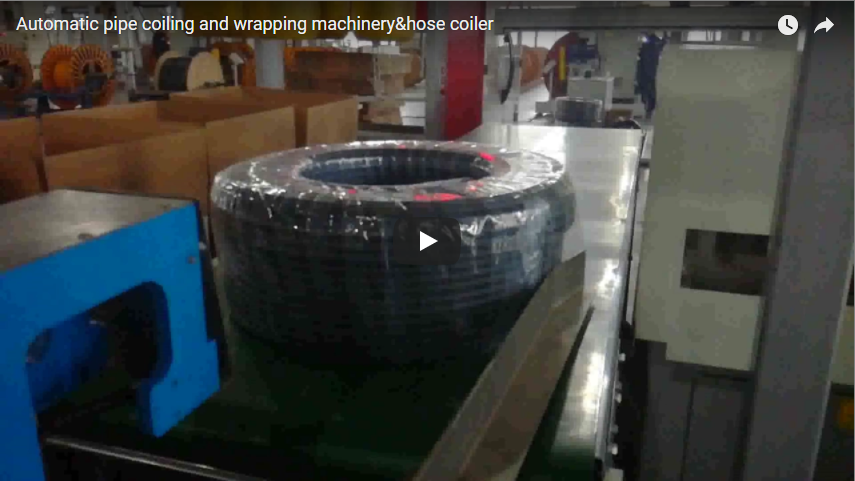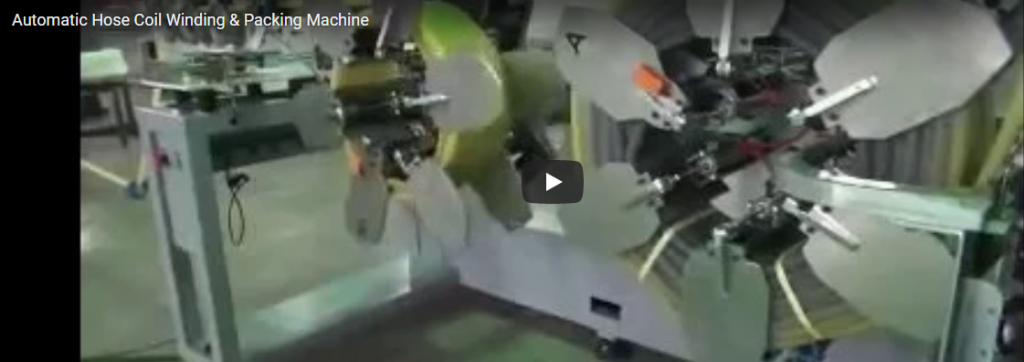Optimizing Extrusion Lines: Advanced Automated Coiling and Strapping Technology
Manual coiling and handling of hoses and pipes downstream from extrusion lines represent a significant bottleneck in modern manufacturing. These processes are often labor-intensive, prone to inconsistencies, and can pose ergonomic challenges. Addressing these inefficiencies is critical for enhancing throughput and maintaining product quality. Automated coiling and strapping systems offer a sophisticated solution, integrating seamlessly into production workflows to deliver consistent, high-quality results while significantly reducing manual intervention.
Drawing upon principles outlined in material handling automation research and leveraging designs similar to those protected by patents focusing on tension control and synchronized winding (e.g., concepts related to dynamic dancer arm feedback loops or servo-controlled traversing mechanisms), these systems automate the entire process from winding to final coil securing.
Core Functionality: Precision Coiling Mechanisms
The heart of the system lies in its precision coiling capabilities. Advanced automated coilers employ sophisticated control systems to manage critical parameters:
- Tension Control: Maintaining optimal winding tension is crucial, particularly for flexible hoses or pipes susceptible to deformation. Modern systems often utilize servo-driven controls coupled with feedback mechanisms (like dancer arms or load cells) to dynamically adjust tension, preventing material stretching or collapse, ensuring consistent coil density and geometry as discussed in polymer processing studies.
- Traversing System: A precisely controlled traversing unit ensures level winding, layering the hose or pipe evenly across the coiling head. This prevents tangling, ensures coil stability, and facilitates easier handling and dispensing downstream. Servo motors typically drive these mechanisms for high accuracy and repeatability.
- Speed Synchronization: The coiling speed must synchronize accurately with the extruder's output rate. PLCs (Programmable Logic Controllers) manage this synchronization, adjusting winding speed dynamically to accommodate variations in line speed, ensuring a smooth, uninterrupted process.
Performance Parameters and Specifications
System capabilities are engineered to meet demanding production requirements:
- Coiling Speed: Variable, typically ranging from 10 to 120 meters per minute, adaptable to extruder output.
- Material Compatibility: Designed to handle a variety of materials including PE (Polyethylene), PEX (Cross-linked Polyethylene), PVC (Polyvinyl Chloride), corrugated pipes, and various types of industrial hoses.
- Pipe/Hose Diameter Range: Configurable to accommodate specific product dimensions (e.g., 10mm - 63mm outer diameter, subject to machine model).
- Coil Dimensions: Adjustable parameters for Inner Diameter (ID), Outer Diameter (OD), and width to meet specific packaging and handling needs.
- Control Interface: User-friendly HMI (Human-Machine Interface) for setting parameters, monitoring status, and diagnostics.
Integrated Automated Strapping
Once the desired length is coiled, the system seamlessly transitions to the strapping phase:
- Automatic Cutting & Feeding: The hose/pipe is automatically cut to the programmed length.
- Coil Ejection/Transfer: The finished coil is typically ejected or transferred automatically to a strapping station.
- Strapping Application: Industrial strapping heads apply polypropylene (PP) or polyester (PET) straps at predetermined positions (e.g., 2, 3, or 4 straps per coil).
- Sealing Method: Straps are securely joined using methods like heat sealing or ultrasonic welding, providing robust coil containment.
- Cycle Time: The strapping process is optimized for speed, minimizing dwell time and maximizing throughput.
Design Considerations and Safety Integration
Adhering to industrial design best practices, these machines emphasize:
- Robust Construction: Built with high-quality materials and components for durability and reliable operation in demanding industrial environments.
- Safety Features: Incorporate safety interlocks, emergency stops, and physical guarding compliant with relevant safety standards (e.g., ISO 12100, ISO 13849) to protect operators.
- Ease of Maintenance: Designed with accessibility in mind for routine maintenance and servicing.
- Modularity: Some designs offer modular components for easier customization or future upgrades.
Enhancing Operational Efficiency and ROI
Implementing automated coiling and strapping technology delivers tangible benefits:
- Reduced Labor Costs: Significantly minimizes the need for manual labor in coiling, strapping, and handling tasks.
- Increased Throughput: Continuous, automated operation eliminates bottlenecks associated with manual processes.
- Improved Product Quality: Consistent tension control and precise winding result in uniform, high-quality coils free from damage or deformation.
- Enhanced Safety: Reduces risks associated with manual handling and repetitive motions.
- Process Consistency: Automation ensures every coil meets predefined specifications for length, dimensions, and strapping.
This advanced automated solution represents a significant upgrade for hose and pipe extrusion lines, driving efficiency, quality, and safety. It aligns production capabilities with the demands of modern, high-volume manufacturing.
For more details on related pipe handling solutions, explore our comprehensive Pipe Packing Machine options.






